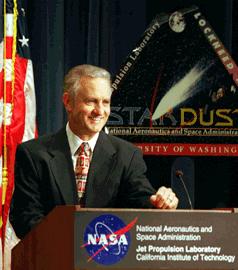STARDUST Status Report
January 8, 1999

Ken
Atkins
STARDUST Project Manager
Well, Happy New Year, Everyone! Welcome to 1999, the year of our STARDUST
launch. It is now under a month until lift off on February 6. It seems
like such a short time ago the selection of STARDUST was announced by NASA
as the fourth Discovery mission. That was in November 1995. And now we are
looking at the spacecraft in final configuration, ready to be mated to the
3rd stage of our Delta II rocket. The first stage is already sitting on
Pad 17A and the Boeing folks are working steadily to stack the second stage
and prepare for STARDUST's arrival on the pad on 28 January.
The spacecraft is in very good shape. Just before Christmas, the sample
return capsule was checked over and closed up for the last time (on Earth),
as Dr. Brownlee completed the final inspection of the aerogel collector
grid. Since then, we have been steadily running the spacecraft through a
series of tests to insure the computer software that will care for and
monitor the spacecraft during the flight is working properly. We keep
electric power on as much as practical to "burn in" the electronics and insure
all is working properly. As you can tell, if you've been watching the action
via the webcams, lots of action has occurred since STARDUST arrived here at
Kennedy Space Center on November 11.
Last week the launch and operations team completed the final Mission
Readiness Review, communicating to NASA, JPL and Lockheed Martin Senior
Managers that we are on track to meet our launch date. The team also went
through a rehearsal of the launch countdown, blast-off, and initial
acquisition of the telemetry from the spacecraft after it separates from
the launch vehicle in space. The spacecraft itself played a major part in
this rehearsal as real telemetry from its subsystems was sent from its
radio system as it sat in the clean room here at Kennedy Space Center. Such
practice is essential in testing the full end-to-end command and control
system, simulating as close as possible the actual events of launch day.
It was exciting to work through the communications and to know that
controllers in Denver and at JPL were getting the signals from the
spacecraft just as they will on February 6. The big difference, of course,
is the spacecraft is here in Florida and not departing Earth for Wild 2.
Having this test activity is crucial to ensuring everything is working
together just as it should.
Next week we will be continuing to test, test, and test more as we make
preparations for mating with the upper stage of the Delta II and the move
of STARDUST to the launch pad on January 28. The "train" is marshalling at
the station, and soon we'll be hearing the "All Aboard!"
Stay tuned!
For more information
on the STARDUST mission - the first ever comet sample
return mission -
please visit the STARDUST home page: http://stardust.jpl.nasa.gov
